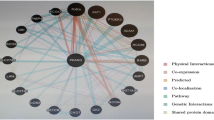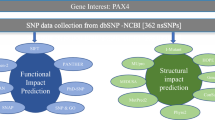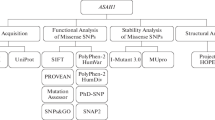Abstract
The present study was conducted with the aim to predict the possible associations of Apo E gene SNPs with a deleterious effect on the structural and functional properties of Apo E using different databases such as nucleotide polymorphism database (dbSNP), SIFT, PolyPhen-2 and F-SNP database. The study was performed during 2017–18 using in vitro bioinformatics tools. Bioinformatics tools such as SIFT, PolyPhen-2 and I Mutant 2.0 were used in this study for single amino acid substitution to know tolerance index (TI), protein function and protein stability effects. F-SNP database was used for the identification of disease-causing SNPs. At dbSNP, the data for 333 SNPs were retrieved of Apo E gene. From the study analysis, 333 SNPs were retrieved, of which 63 were nsSNPs and 12 were UTRs and others were located in other regions. From the results, it was inferred that out of 63 nsSNPs, 8 were predicted as ‘Damaging’ with (TI) < 0.05. The SNPs such as rs41382345, rs769455, rs11083750, and rs769455 had a TI score of 0.00 which affect Apo E protein function. Ten nsSNPs were found to secure FS score > 0.5. One nsSNP secured the least FS score i.e., rs41382345(0.273). The results in prediction reveals that nsSNPs of Apo E protein have an deleterious impact upon protein function and structure which may lead to serious human health problems. In humans, apolipoprotein E (Apo E) has a vital role in the proper regulation of lipid metabolism. Apo E gene polymorphisms have been associated with coronary heart disease, obesity, diabetes, hypertension, cancers and Alzheimer’ disease. This analysis must be valuable for future genomics, pharmacoproteomics and clinical studies.

Similar content being viewed by others
References
Aalto-Setala K, Palomaki H, Miettinen H et al (1998) Genetic risk factors and ischaemic cerebrovascular disease: role of common variation of the genes encoding apolipoproteins and angiotensin-converting enzyme. Ann Med 30:224–233
Capriotti E, Fariselli P, Casadio R (2005) I-Mutant2.0: predicting stability changes upon mutation from the protein sequence or structure. Nucleic Acids Res 33(suppl_2):W306–W310
Cartegni L, Wang J, Zhu Z, Zhang MQ, Krainer AR (2003) ESEfinder: a web resource to identify exonic splicing enhancers. Nucleic Acids Res 31(13):3568–3571
Clair CS, Visick JE (2013) Exploring bioinformatics. Jones & Bartlett Publishers, Burlington
Clifford RJ, Edmonson MN, Nguyen C, Scherpbier T, Hu Y, Buetow KH (2004) Bioinformatics tools for single nucleotide polymorphism discovery and analysis. Ann N Y Acad Sci 1020(1):101–109
Finch CE, Stanford CB (2004) Meat-adaptive genes and the evolution of slower aging in humans. Q Rev Biol 79(1):3–50
Gibson NJ (2006) The use of real-time PCR methods in DNA sequence variation analysis. Clin Chim Acta 363:32–47
Hanh NTH, Nhung BT, Dao DTA, Binh TQ, Thuc VTM (2016) Association of apolipoprotein E polymorphism with plasma lipid disorders, independent of obesity-related traits in Vietnamese children. Lipids Health Dis 15(1):176
Hardy J, Singleton A (2009) Genomewide association studies and human disease. N Engl J Med 360(17):1759–1768
Hindorff LA, Sethupathy P, Junkins HA, Ramos EM, Mehta JP, Collins FS, Manolio TA (2009) Potential etiologic and functional implications of genome-wide association loci for human diseases and traits. Proc Natl Acad Sci 106(23):9362–9367
Huebbe P, Rimbach G (2017) Evolution of human apolipoprotein E (APOE) isoforms: gene structure, protein function and interaction with dietary factors. Ageing Res Rev 37:146–161
Kopelman PG (2000) Obesity as a medical problem. Nature 404(6778):635–643
Kuusisto J, Mykkänen L, Kervinen K, Kesäniemi YA, Laakso M (1995) Apolipoprotein E4 phenotype is not an important risk factor for coronary heart disease or stroke in elderly subjects. Arterioscler Thromb Vasc Biol 15(9):1280–1286
Marrzoq LFA, Sharif FA, Abed AA (2011) Relationship between ApoE gene polymorphism and coronary heart disease in Gaza strip. J Cardiovasc Dis Res 2(1):29–35
Masoodi TA, Al Shammari SA, Al-Muammar MN, Alhamdan AA (2012) Screening and evaluation of deleterious SNPs in APOE gene of Alzheimer’s disease. Neurol Res Int 2012:8
Miller DB, Hegele R, Wolfe BM, Huff M (1995) Identification, molecular characterization, and cellular studies of an apolipoprotein E mutant (E1) in three unrelated families with hyperlipidemia. J Clin Endocrinol Metab 80(3):807–813
Ng PC, Henikoff S (2003) SIFT: predicting amino acid changes that affect protein function. Nucleic Acids Res 31(13):3812–3814
Pablos-Méndez A, Mayeux R, Ngai C, Shea S, Berglund L (1997) Association of apo E polymorphism with plasma lipid levels in a multiethnic elderly population. Arterioscler Thromb Vasc Biol 17(12):3534–3541
Ramensky V, Bork P, Sunyaev S (2002) Human non-synonymous SNPs: server and survey. Nucleic Acids Res 30(17):3894–3900
Reumers J, Schymkowitz J, Ferkinghoff-Borg J, Stricher F, Serrano L, Rousseau F (2005) SNPeffect: a database mapping molecular phenotypic effects of human non-synonymous coding SNPs. Nucleic Acids Res 33(suppl_1):D527–D532
Shastry BS (2002) SNP alleles in human disease and evolution. J Hum Genet 47:561
Skoglund-Andersson C, Ehrenborg E, Fisher RM, Olivecrona G, Hamsten A, Karpe F (2003) Influence of common variants in the CETP, LPL, HL and APO E genes on LDL heterogeneity in healthy, middle-aged men. Atherosclerosis 167:311–317
Solanas-Barca M, de Castro-Orós I, Mateo-Gallego R, Cofán M, Plana N, Puzo J et al (2012) Apolipoprotein E gene mutations in subjects with mixed hyperlipidemia and a clinical diagnosis of familial combined hyperlipidemia. Atherosclerosis 222(2):449–455
Udenigwe CC (2014) Bioinformatics approaches, prospects and challenges of food bioactive peptide research. Trends Food Sci Technol 36(2):137–143
Yue P, Melamud E, Moult J (2006) SNPs3D: candidate gene and SNP selection for association studies. BMC Bioinform 7(1):166
Author information
Authors and Affiliations
Corresponding author
Ethics declarations
Conflict of interest
Author has no conflict of interest to be disclosed.
Research involving human participants and/or animals
This research does not report any testing result from human participants or animal use.
Informed consent
No informed consent was required for this study.
Rights and permissions
About this article
Cite this article
Saeed, N.A.A.A.H., Hamzah, I.H., Ali, A.N.M. et al. Prediction of single nucleotide polymorphisms (SNPs) in apolipoprotein E gene and their possible associations with a deleterious effect on the structure and functional properties: an in silico approach. Netw Model Anal Health Inform Bioinforma 7, 16 (2018). https://doi.org/10.1007/s13721-018-0178-9
Received:
Revised:
Accepted:
Published:
DOI: https://doi.org/10.1007/s13721-018-0178-9




